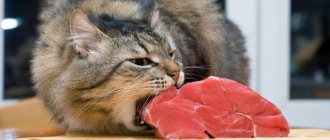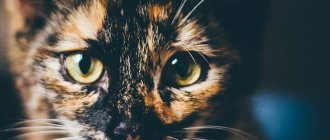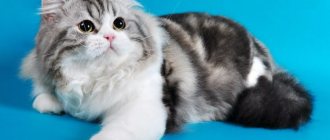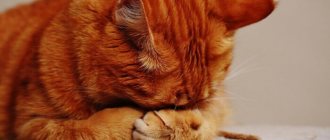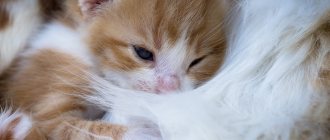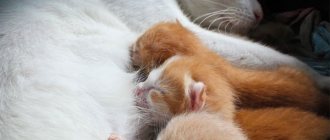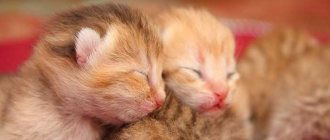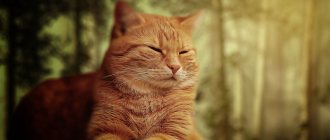Underweight is no less dangerous than obesity. Most often it is associated with poor living conditions and selectivity in food. Because of this, many owners try to cope with the problem on their own and are looking for ways to fatten their cat without seeking help from a veterinarian.
But we must not forget about pathological factors that affect appetite and nutrient absorption. In these cases, the animal requires mandatory treatment, so to be on the safe side, it should be scheduled for examination at a veterinary clinic.
Is fattening required?
How can you tell if a cat is thin, has a normal weight, or is “fat”? First of all, there are a number of important points to note:
- The owner should not compare it with the pets of friends, neighbors, or close relatives. After all, in this matter there is individuality. Even 2 kittens from the same litter can have different constitutions: 1 is excessively thin, and the second is well-fed.
- If we are talking about purebred pets, then there are certain standards. Typically, the table indicates both minimum and maximum data - height and body weight.
- If the cat is of “noble” origin, then you will have to navigate “by eye,” or rather, by touch. The animal should be placed in a standing position - the front legs are straight, the hind legs are slightly pulled back, in the direction of the tail. You need to feel his spine, it should be smooth. While stroking your pet, the outer ribs should not be felt, and this is considered normal. Then the pelvic part is palpated - a moderately well-fed animal has a smooth croup, with slightly protruding knuckles. The abdomen may be taut or slightly saggy. When moving, a fold forms in the peritoneum area - this is also normal. There is a thin layer of fat on the sternum and abdomen that can be felt.
As a rule, even skinny representatives of the species develop a small layer of fat in the cold season.
External signs of thinness. A pet can be called thin if it has:
- the spinal column and ribs are visible upon visual inspection;
- the hip joints clearly protrude into tubercles;
- a depression is noticeable in the area of the peritoneum;
- the muscles of the forearms, hind limbs, and sternum “fall off.”
The constitution and muscle tone of the animal are always taken into account. Many of the cats appear thin in appearance, but at the same time they have developed muscles.
We make a calculation.
It is impossible to calculate the “ideal” weight of a pet using mathematical calculations of coefficients or a formula.
For example, the standard weight of “British women” varies from 4.2 to 6.8 kg. However, there is a recorded case where a male of this breed reached a weight of just under 14 kg. At the same time, he was physically healthy, although the giant was still excluded from breeding (read in the article how much a cat should weigh depending on breed and age).
Causes of cat emaciation: fattening or treating
In some cases, pet weight loss is associated with quite predictable physiological factors:
- Feeding numerous litters.
- Hunger - the cat lives on the street or for some other reason has been deprived of food.
- A combination of stress and hunger - the cat got lost and did not leave a secluded place for a long time.
- Dehydration (severe dehydration) resulting from vomiting and/or diarrhea.
- Medical intervention - after intensive therapy, strict dietary restrictions, complicated pathologies.
- Failure of metabolic processes - metabolic disorders can be congenital or acquired. In the latter case, this may occur due to mixed feeding of natural food and industrial feed.
- Dysbacteriosis – develops as a result of an innate tendency to eat inedible things.
All of the above slows down metabolic processes, the cat slowly, gradually loses weight. But if the owner notices changes in a timely manner and takes appropriate measures, the pet will quickly return to its normal physical shape.
When fattening won't help. However, it is not possible to cope with the problem by strengthening your pet’s diet in all cases. This method will not lead to a positive result:
- When an animal is infected with helminths, it requires anthelmintic therapy.
- If a cat becomes infected with an intestinal infection, the disease is accompanied by diarrhea, vomiting, dehydration and requires comprehensive treatment.
What to do? If your pet refuses to eat, rapidly loses weight, and his condition worsens, then there is no time to waste. You should contact a veterinary clinic for professional help as soon as possible.
Mistakes and dangers
A common belief is that cats will not eat anything that can harm them. In fact, this is not so; pets often eat food that is not healthy and even harmful to them. Most often this happens because their owners make the following mistakes:
- They feed from the table. Pets often ask to share human food, and not all owners can resist. Remember, your food contains a large amount of salt and spices, which are harmful to the digestion of animals.
- Mix types of food. Decide on your pet’s type of food: natural or industrial food. Both methods have their advantages and disadvantages, but combining them leads to indigestion.
- They ignore daily norms. It is easy to feed a cat to be fat, since this simply requires giving him an unlimited amount of food every day. If you do not pursue such a goal, it is better to stick to the daily intake (discuss with your veterinarian).
- They switch abruptly from one type of food to another (from natural to dry food). The change in feeding method must be smooth, otherwise the pet will develop vomiting or diarrhea.
Foods that promote weight gain
When an animal does not have serious health problems and at the same time has a “thin” constitution, it is advisable for the owner to review its diet and change some feeding rules, namely:
- When choosing a menu, you should take into account your pet’s taste preferences.
- It is recommended to enrich the diet with high-energy foods. They should contain a large amount of protein, not fat, because the cat should build muscle mass, and not increase body fat.
- It is imperative to adhere to the established feeding schedule.
- The one- or two-time regimen is replaced by fractional, 5-6 meals a day. The daily intake should be divided into small portions.
A set of healthy products for fattening . Not all products will be useful for a “properly fattening” cat. But it is advisable to include in the menu:
- Beef, chicken - they contain a lot of animal protein and should become the basis of the animal’s diet.
- Oatmeal and bran are a source of coarse fiber that stimulates the functions of the digestive tract. It is recommended not to boil them, but to pour boiling water over them and keep them covered for a quarter of an hour.
- Rice and buckwheat are grains that can be given to cats. But they should not be the basis of the menu.
- Vegetables: carrots, zucchini, pumpkin, green beans. They are boiled, pureed and mixed with other ingredients.
- Liver, kidneys, heart (turkey, chicken, beef) - it is better to boil or scald with boiling water before serving.
- Chicken or quail egg - usually cats are given only a boiled yolk, 1-2 times every 7 days.
- Ocean or sea fish - it is first boiled and the bones are removed. Giving your cat this food a couple of times a week is enough. But you shouldn’t feed your pets river fish; they are often infected with parasites.
- Cartilage jellied meat is a product rich in collagen, which is beneficial for joints.
- Low-fat fermented milk products: cottage cheese, kefir, yogurt, yogurt. They should not contain sugar or artificial additives. Cream can also be given, but it must first be diluted with boiled water or milk.
- Cheese – low fat. A cat only needs a couple of small slices a week.
- Baby formula and cereal without any additives.
- Baby purees – meat, meat and vegetable. Bean and potato products should be avoided.
Additional measures
Unfortunately, mustachioed striped animals often find themselves in dangerous situations and their emaciation leads to pathological changes in eating behavior. It is often necessary to awaken a cat's interest in food before feeding it. There are several means for this:
- Vitamins . You should choose a suitable vitamin complex for your pet, which will help restore the animal’s body and provide it with useful substances. Cats are not always happy to take vitamin supplements. But even if the pet resists, the owner should be persistent. Tablets or dragees can be crushed to a powder state, diluted with water and poured into the cat’s mouth using a syringe without a needle. Also, drugs in solid forms can be crushed and mixed with food.
- Beneficial bacteria . It is recommended to give your pet probiotic products consisting of bifidobacteria and lactobacilli 30 minutes before meals. They normalize the intestinal flora, suppressing the activity of microbes that cause dysbiosis. In addition, lactobacilli are involved in strengthening the immune system, which is important for both sick and healthy pets. The most useful probiotics that have a positive effect on the animal’s intestinal microflora: Bifitrilak, Zoonom, Subtilis, Enterol, Lactobifadol, Olin, etc. It is allowed to use drugs from a regular pharmacy, for example, Lactobacterin, Bifidumbacterin.
Dry food for weight gain
Today, many owners switch their pets to ready-made diets, or the animal ends up in a home with already established taste habits. What food is suitable for your pet to gain weight to normal? According to clinical studies:
- The product must be premium or super-premium and not contain chemical additives.
- It is desirable that the composition contains vitamins and coarse plant fibers that are beneficial for digestion processes.
- Many manufacturers produce lines of special diets designed for pets that are gaining weight. It is worth paying attention to similar products labeled Gastro Intensinal.
- Must consist of high-quality ingredients - meat, grains, offal, and in composition be as close as possible to the animal’s usual complete diet. Ready-made food is valued not only for the composition of its components, but also for their proper combination and ratio.
- It is important to adhere to the recommended dose; it is usually indicated on the back of the package. For more accurate dosage, it is better to use a measuring cup or spoon. Often the owner thinks that his pet eats too few granules and does not finish eating. However, it is worth considering that the satiety of the diet is sometimes not related to the serving size. Typically, the consumption of a high-quality product is much lower than that of cheap, low-quality diets.
When “fattening” your pet, you should not significantly increase the portion of food. This is more likely to lead to problems with digestive processes than to restoring body weight.
Iron and iron health: what role does the microelement play in our body?
Iron is part of hemoglobin. In turn, the protein hemoglobin is a building material for erythrocytes - red blood cells that carry oxygen from the lungs to the organs, and on the way back rid them of carbon dioxide. Actually, this process is called cellular respiration. Without iron it is impossible. And since every cell in our body needs oxygen, iron can be called one of the most important elements.
The synthesis of hemoglobin takes 60–70% of all iron entering the body. The remaining 30–40% is deposited in tissues and spent on solving other problems - metabolic processes, regulation of the thyroid gland, maintaining the body's defense system and connective tissue synthesis.
As you can see, the functions of iron are varied and numerous, but oxygen transport is the most important of them.
Iron is poorly absorbed even with ideal health and proper diet - the human body is able to absorb up to 10% of the iron supplied with food.
What are the dangers of excessively fattening a pet?
You can fatten a cat only if it is really thin and this negatively affects its health. You should act carefully, adhering to certain rules. However, some owners go beyond all restrictions and begin to feed their pet intensively in order to “improve” its aesthetic appearance. A purring chubby cat looks funnier than a skinny cat, moves much funnier and evokes affection in those around him. But before deliberately harming a pet, the owner should learn about the dangerous consequences of feline obesity:
- Type II diabetes (non-insulin dependent) - even if the animal does not have a tendency to this disease, then an incorrect lifestyle and a disrupted diet can cause its development. As a result, the owner will have to give the pet insulin from time to time to prevent a sharp deterioration in its condition. Veterinarians consider diabetes mellitus to be the most dangerous consequence of overfeeding pets.
- Diseases of the cardiovascular system - the more excess weight a cat has, the higher the load on the heart. Most overweight pets have low motor activity, they mostly lie down and run a little, which leads to a worsening of the situation. Heart pathologies associated with obesity often lead to attacks that provoke a heart attack in the animal.
- Injury to bones and joints - if an obese pet retains its playfulness, then jumping long distances can result in damage to the skeletal system: dislocations, fractures, sprains. Since the articular-ligamentous apparatus is “sharpened” for a certain weight, its significant increase will turn out to be a very traumatic condition.
- Low ability to recover - obese animals take longer to recover from injuries and illnesses, including due to intense stress on joints and other tissues.
- Predisposition to inflammatory joint diseases - arthritis. Statistics show that overweight cats are the first to be at risk for developing this unpleasant disease. The pathology is accompanied by tissue inflammation and curvature of the limbs. In complicated cases, suppuration occurs. Advanced forms of arthritis can only be treated with surgical methods.
- Hypertension – at the initial stage of development, the disease is difficult to diagnose, but it is very dangerous for the health of the pet. Chronic hypertension leads to cardiac hypertrophy, which, with accompanying factors, can result in organ failure.
The owner of a cat should know that for her an extra kilogram and a half is already considered obesity, an unsafe condition for health. Therefore, before feeding your pet intensively, you should find out whether he needs such changes? After all, you can harm an animal even with the help of overprotection, indulging the whims of a purring friend.
Iron intake standards for patients with anemia
Sometimes tests reveal not just a lack of iron, but a more serious situation - iron deficiency anemia. Typically, this condition develops against the background of gastrointestinal diseases, tumor processes, helminthic infestations, and constant bleeding. It is often diagnosed in people who have experienced significant blood loss during injury or surgery.
Iron deficiency anemia is diagnosed if the hemoglobin level drops to 100–70 g/l and serum ferritin drops to 15 ng/ml.
If iron deficiency anemia is diagnosed, you cannot prescribe treatment yourself. The doctor selects the therapy. Perhaps he will prescribe multivitamin complexes and dietary supplements with iron, and in the most severe cases, he may even prescribe iron supplements - quite strong drugs with numerous side effects. You can take such medications only under the supervision of your doctor.
Cat food for weight gain
The painful thinness of animals is an indicator of an increased struggle of the immune system against a lack of body resources. An animal can be considered thin if its ribs and spine are visually visible, hip joints protrude, there are depressions in the peritoneum with visualization of vascular pulsation, weak and saggy muscles on the hind and front legs, in the forearms and in the chest. In this case, the cat is prescribed a special food that allows it to gain weight. In addition, she needs to be provided with proper care.
Nutritional Features
Ready-made cat food for weight gain from well-known manufacturers contains all the necessary nutrients per daily requirement. The main emphasis is on proteins and carbohydrates. Fats in such products are contained in minimal quantities, since the purpose of taking them is to gain muscle mass, not fat. In addition, fatty foods put a lot of stress on the liver.
In nature, squirrels make up 85-90% of the diet of wild felines. Feed manufacturers strive for this indicator. But in a weight gain diet, proteins are most often replaced with carbohydrates. This allows you to quickly achieve the desired result.
Ready-made food for cats, recommended for weight gain, contains vitamins, proteins and coarse fibers to normalize intestinal function.
Attention! It is not recommended to give your cat food to gain weight on an ongoing basis. In most cases, this food is prescribed for 2 months. After this period, the animal’s weight should return to normal.
Sources of fats
This element must be included in a cat’s natural diet, since it is not only, along with carbohydrates, a source of energy, but also supplies the body with many vitamins:
- A - improves vision, is responsible for the condition of the skin and coat;
- D - is of great importance for the formation of the skeleton;
- E - strengthens muscles, regulates the normal functioning of the genitourinary system;
- K - is an important element for strengthening joints and bones, and the functioning of the cardiovascular system.
In addition, fats give food an attractive taste and smell, promote intensive growth and harmonious development of the animal. Their share in the pet’s diet with natural nutrition should be at least 20%.
If it is not possible to provide the animal with food with a sufficient amount of these components, then fish oil can be added to it.
Food from popular manufacturers
There are medicinal products for weight gain in the veterinary lines of different manufacturers. They are an excellent alternative to eating from the hosts' table.
Royal Canine
If you fed your pet an unbalanced diet, and as a result he began to lose weight, he began to shed hair, began to vomit, and his general condition became lethargic, after the necessary treatment, the doctor will probably recommend you a diet for weight gain.
Gastro Intensinal
One such food is dry granules “Royal Canin Gastro Intensive” moderate calorie. This product contains the following ingredients:
- meat;
- liver;
- fats and oils;
- cereals;
- minerals;
- plant products;
- yeast;
- carbohydrates;
- food and technological additives.
Prescribed to cats losing weight as a result of digestive problems along with taking the necessary medications. Cats that were previously indifferent to dry food invariably show interest in it.
Attention! If you feed your animal dry food, make sure it always has fresh water. It helps improve digestion when taking dry granules.
As a result of feeding Royal canin gastro intestinal, the animal not only actively gains weight, but also sheds less, drinks more, leads a more active lifestyle, and the smell in the cat litter becomes less pungent.
Recovery
To gain weight, manufacturers offer not only dry food, but also canned food. Recovery canned food is prescribed to cats and dogs for recovery during the period of anorexia and after recovery, during intensive care, during pregnancy and feeding offspring, for liver lipidosis in cats, as well as for kittens during the growth period.
It contains the following components:
- meat;
- liver;
- vegetable by-products;
- cereals;
- fats and oils;
- dairy products;
- minerals;
- carbohydrates;
- eggs;
- yeast.
The feeding scheme for anorexia in cats is shown in the figure:
The composition provides the body with all the necessary substances and compensates for the decrease in body weight of cats that are picky eaters. This food is suitable for tube feeding if the animal is unable to feed itself.
Important! When feeding through a nasoesophageal tube with a diameter of less than 3.3 mm, the feed must be diluted with water in a 1:1 ratio.
- hepatic encephalopathy;
- acute pancreatitis and hyperlipidemia.
Purina
The Purina line includes a canned dietary product called Pro Plan Veterinary Diets Gastrointestinal. It is prescribed to animals during the rehabilitation of anorexia and is presented both in the form of croquettes and in the form of canned food.
Gastrointestinal is a complete diet with a high concentration of essential nutrients, easily digestible ingredients, and increased energy value. It contains:
- offal;
- salmon;
- turkey meat;
- animal serum;
- sunflower oil;
- corn starch;
- minerals;
- vitamins.
If a cat loses weight while nursing, she can be given ready-made kitten food or canned food for cats recovering from surgery as a supplement to the main diet.
Attention! Feeding human food to pets is not recommended because it may not provide them with essential nutrients. The same goes for cheap ready-made food.
And in conclusion, it should be said that no matter how much you want your pet to look well-fed and happy, you should not overfeed him. All cats are individual, and even kittens from the same litter can have different body shapes.
What age can be considered correct to buy a kitten?
A small one-month or two-month-old kitten looks funny and very cute. Those who want to get a furry friend think that a kitten at three or four months is already too big, will not be able to quickly get used to a new place, and will play less. The buyer, fascinated by the cute face, does not think about the fact that he will have to replace the kitten’s mother and teach him to eat, use a tray and scratching post, wean him from gnawing wires, biting, scratching and many other important things
And it doesn’t matter whether he’s purebred..
Discussion
Everything is correct) We have reserved our kitty, we will pick it up at 4 months) In the meantime, she hangs out with her sisters, mommy, learns good manners, she gets her first vaccinations and sends us reports and photos)
Our cat came to us at 4.5 months. I managed to see enough of the childish expression and funny behavior. Got used to it instantly.
How to fatten a thin kitten (cat) that was starving?
The main principle of fattening is that the calorie content of food should exceed energy expenditure. Meat should be its main source. Thin animals are fed little by little 5-6 times a day. A large amount of food eaten at once creates excess stress on the digestive organs. You can't suddenly change your diet.
Food should be warm (30–40°C) - in this form it is better absorbed and also smells stronger, which increases appetite. Pre-chopping foods makes digestion easier. The animal must have 24/7 access to clean water. A cat that has been starving is not getting the nutrients it needs, so it should be given vitamin and mineral supplements. First of all, a depleted coma needs vitamins A, C, D, E, and group B.
Why doesn't the animal gain weight?
An animal may not gain weight for a number of physiological and pathological reasons. A cat will often eat less in hot weather, in early pregnancy (due to nausea), and during heat, which is caused by hormonal changes. A cat may refuse to eat if there is a change in food and it does not like the new product. Food refusal can even be triggered by rearranging the cat's bowls.
Weight problems can be caused by stress. It can be caused by a move, a trip to the veterinarian, the owner leaving, the appearance of another animal or child in the house, etc. Weight problems often occur in cats during lactation, especially when many kittens have been born, because a huge amount of energy is spent on milk production, which the body cannot quickly replenish, even if the cat eats well. All these reasons are considered physiological, after a while everything returns to normal.
Excessive thinness is often a sign of illness. Pathological reasons why a cat cannot recover:
- Parasitic diseases. Helminths absorb a lot of nutrients, and even with a good appetite, the cat cannot gain weight.
- Diseases of the oral cavity (caries, tartar, stomatitis). While chewing, the animal experiences pain and therefore refuses to eat.
- Infections (calcivirosis, panleukopenia, viral peritonitis and rhinotracheitis). The waste products of pathogenic microorganisms enter the bloodstream and cause intoxication, which causes the animal to refuse to eat.
- Pancreatitis. When the pancreas is inflamed, enzymes do not enter the duodenum, resulting in poor absorption of nutrients.
- Diseases of the endocrine system. They lead to hormonal imbalances, which causes a decrease in the volume of fat and muscle tissue.
- Diseases of the liver, biliary tract, intestines. They are accompanied by enzyme deficiency and poor absorption of nutrients in the small intestine.
- Diabetes. Due to insulin deficiency, glucose is not absorbed, and the body begins to draw energy from fat reserves, which affects body weight.
- Tumors. Cancer negatively affects hormonal levels, causes intoxication and digestive disorders, especially if it is localized in the stomach, pancreas or liver.
What to feed a natural feeding cat to help it gain weight?
Owners often believe that in order to eliminate weight deficiency, the cat needs to be fed fatty foods (lard, sour cream, pork). This is not true - fatty foods negatively affect the functioning of the digestive tract, disrupting the functioning of the pancreas and liver. The cat needs to be fed low-fat foods with high energy value, little by little but often. Dishes from the human table are contraindicated - they contain a lot of salt, fat, sugar and additives harmful to the cat.
The basis of the diet is veal, lamb, chicken, and rabbit. Meat is given boiled or raw. In the second case, it is first frozen to destroy parasites. If the animal is recovering from surgery, illness, or is severely exhausted, at first it can be given light chicken broth and baby purees with meat.
Twice a week you can give beef or chicken liver, sea fish, eggs. As an addition to meat, the diet should include porridge (oats, rice, buckwheat) and low-fat fermented milk products (kefir, fermented baked milk, cottage cheese, yogurt without additives).
Recipe No. 2
Fresh meat for lunch:
- Chicken breast - 100 g.
- Lean pork meat (can be replaced) - 30 g.
- Rice - 1 tbsp. spoon.
- Chopped parsley - a handful.
- Vegetable oil - 1 teaspoon.
Chop the meat with a knife and mix with the rest of the ingredients. Store for no more than 2 days.
Fresh meat for lunch
Review of high-calorie cat foods
Medicinal high-calorie food is a good alternative to natural food. They are balanced and designed specifically so that the animal can gain weight, and the owner does not need to waste a lot of time on cooking. Several manufacturers have lines for malnourished cats. Such feeds have a high calorie content, increased palatability, and increased protein content. They contain vitamins and minerals necessary for recovery.
If the animal is severely emaciated, at first it is better to give it canned food in the form of pate - food of this consistency is better absorbed. After diluting with water, they can be used for feeding using a syringe or tube. They can be fed to both an adult cat and a kitten. Since such foods contain a lot of proteins and fats, they are contraindicated for diseases of the liver and pancreas.
Canned food for weight gain:
- Royal Canin Recovery. Well suited for animals with reduced appetite - it has good taste and is high in calories, so even a small amount of food will provide your pet with nutrients. It contains a complex of antioxidants that protect cells from oxidation, helping to strengthen the immune system.
- "Eukanuba High Calorie". It has a high level of nutrients and an optimal ratio of omega-3 and omega-6 fatty acids. Contains sugar beet pulp, which has a beneficial effect on intestinal function. Can be used as a therapeutic food for diabetes, heart and vascular diseases.
- Hill's a/d. Contains easily digestible components, a lot of protein, and has a rich vitamin and mineral composition. The food is highly palatable.
You can fatten underweight animals using the following dry food:
- "Royal Canin Convalescence Support Cat." Designed for recovery after illnesses and operations, suitable for exhausted animals. Allows you to quickly gain muscle mass due to a large amount of protein, has a pleasant taste, contains antioxidants and chondroitin, which improves the condition of joints and cartilage.
- "Eukanuba Renal." The food is suitable for cats whose thinness is associated with kidney and liver diseases. Contraindicated during pregnancy and lactation.
- "RENAL SPECIAL RSF 26". Designed for pets with chronic renal failure, accompanied by loss of appetite and poor digestibility of food.
- "Royal Canin Senior Consult Stage 2 High Calorie." High calorie food for cats and kittens over 7 years old. With age, the ability to absorb fats decreases, so food should be more nutritious. The product contains antioxidants and chondroprotectors, helps maintain normal functioning of the kidneys and urinary system.
Is it worth feeding a cat so that it becomes fat, which could lead to obesity?
According to statistics, fat cats live less than their counterparts with normal body weight by 2-3 years. Obesity threatens the following health problems:
- Diseases of the musculoskeletal system. Due to severe stress, the cartilage gradually wears away, causing severe pain, lameness and limited mobility. The risk of injury increases.
- Cardiovascular diseases. The load on the heart increases, the muscle works harder. Plaques appear on the vessels, impeding blood circulation and causing a lack of oxygen.
- Diabetes. The disease develops as a result of a metabolic disorder caused by a lack of insulin production or a decrease in tissue sensitivity to it, due to which carbohydrates that are not properly processed enter the blood.
- Liver pathologies. Fatty deposits appear in the organs, negatively affecting its functioning.
Since excess weight poses a threat to your pet's health, it is necessary to normalize it as soon as possible. First of all, establish the cause. Obesity can be a consequence not only of overfeeding, but also of hormonal imbalance, metabolic disorders, and chronic diseases. The animal is switched to a low-calorie diet and its physical activity is increased.
Sources:
https://porodakoshki.ru/chem-kormit-koshku-dlya-nabora-vesa/ https://usatiki.ru/korm-dlya-koshek-dlya-nabora-vesa/ https://murkoshka.ru/kormlenie/ korm-dlya-koshek-nabora-vesa.html
Recipe No. 5
Milk breakfast:
- Powdered milk - 1 tbsp. spoon.
- Chicken eggs - 2 pcs.
- Cottage cheese - 3 tbsp. spoons.
- Chopped vegetables - 2 tbsp. spoons.
Add a few tablespoons of cold water to the milk powder, then beat in the eggs and bring the mixture until smooth. Gradually stir in cottage cheese and vegetables. Pour the mixture into the pan and cook for 2 minutes on each side. Cool, cut and serve to your pet.
Milk breakfast
Attention! Remember, no salt or spices should be used in any recipe. They will irritate the animal’s receptors, which will negatively affect its sense of smell and perception of taste.
